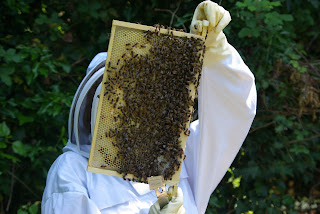Serious achievement: lighting my smoker all by myself!!
Starting with a little soft cardboard from an egg box...
Add some bone dry rotted wood
Pack it in nice and tighly and flip on the lid.
puff the bellows a few times to keep it all alight, and it was ready to go.
A little smoke in the hive entrance tells the bees "There may be a fire nearby - gorge yourself on nectar in case we have to evacuate."
Once full of honey, the bees are conditioned not to sting: stinging means death to a bee. Death for a full bee means a stomach full of honey lost for the colony. If you look at the pics below, you'll see a number of bees with their heads shoved in a cell - they are sucking up as much nectar as they can at that moment.
 |
| The lid is off - I had a few lumps of rogue comb to remove from the tops of the frames, then... |
 |
| lift out a frame to see what is going on. Just a few bees on there huh? |
In just two weeks they had pulled out the wax to make comb on about 80% of the brood frames, and the queen had clearly been hard at work laying - I had the full compliment of brood: eggs, larvae in different stages of growth - all pearly white and curled up in their snug little cells - and capped larvae, pupating into bees behind a wax door.
All good healthy signs to see.
At least 5 frames had brood laid in them, all showing a lovely classic pattern - an oval of eggs/larvae/capped larvae in the middle, pollen in an arc above that, and nectar or capped honey in the top corners.
Another good sign is that all the capped larval cells were for worker bees. No drones larvae means no one is planning on a mating flight, which means the colony is not planning to swarm again....phew.
 |
| The palest coloured open cells contain juicy fat larvae. The wax capped cells have pupating bees in them. All workers - nice flat wax caps. |
Several frames at either end of the brood box were being drawn out and filled all over with nectar for food stores.
There were two frames at one end that had not been touched. Bees tend to lay symmetrically starting in the middle of a brood box and working out evenly on each side. I'll keep an eye on that. I might have to move my empty frames to be included in the symmetrical pattern so that they don't become wasted space.
Joy of joys! I saw the her majesty herself, calmly wondering around on a frame, attended by some workers, with plenty of tiny freshly laid eggs in evidence.
 |
| The queen is hard to spot for a beginner, so I was thrilled to see her. She is about 1/4 inch longer in the abdomen than the workers. |
My biggest concern is to make sure there is plenty of space. Since they came as a swarm, they would not think twice to swarm again if I let them get cramped.
A quick reference back to my bee books and notes from my classes confirmed my hunch - time to get my first super in place. Perhaps having more space to store only honey will free up some of the brood frames for the queen to lay in.




Fantastic looking hive. The whole family enjoyed reading about your hive. So wish we could see it in person. I knew the bees would be happy in your garden
ReplyDeleteHi Rebecca,
ReplyDeleteMark forwarded your blog and it's been a joy to read. Utterly fascinated by the bees and completely shocked at how much the children have grown.
I promised Mark we'd Skype soon and would love to hear more about life with bees.
All the best,
Loganberry